Cubana de Aviación Tupolev TU-154B-2 CU-T1256 Phoenix Models 1:400
- Jorge A. Zajia

- Aug 25, 2023
- 6 min read
Updated: Aug 27, 2023
Intro
The aircraft liveries of the 1990s generally are not considered the most exotic. Gone were the decorative window cheatlines of the 70s and 80s, but the curvy smooth designs of the 2010s were still under the horizon. This left us with formal, business-like designs adorning the eye-catching airliners that were common during those days. For those of us airplane lovers who grew up during that decade, models with those liveries can easily send us down nostalgia lane, in spite of their rigid feel.
Such is the case with me and the subject of this overview, a Tupolev TU-154 in the 1990s Cubana livery.

It was the mid of the 1990s, my mom and I were at Maiquetía Airport (greater Caracas) changing airplanes as we returned home to Maracaibo from Barcelona (VE). I loved these opportunities to spend time at airports watching airplanes. It was late afternoon and Maiquetía was buzzing. 727-200s from several local carriers, as well as many foreign carriers from the Andean region and the U.S. were coming in constantly as the Euro heavies launched eastward over the Caribbean sea back to the old world.
Suddenly, a Cubana tri-jet appeared on short final. The runway was a bit far, but the big, bright, red titles made it easy for me to identify the airline. As far as the aircraft type goes, of course I thought it was just another 727 joining the party. Not quite, I was about to find out.
As the aircraft gracefully taxied back to the terminal, it passed in front of where I was, this time much closer. First, the nose, what had happened to that traditional Boeing nose? Then the main landing gear; it had bogies like those found on widebodies. And then that archaic-looking thing sticking out of the top of the tail; reminded me of the toy 707s that I had. What an exotic aircraft, a surreal 727-200.
It would take years before I could track down the aircraft type, learn about the existence of Soviet aviation, and learn about the Cuban revolution. It would take even more years before I saw another one of these birds in real life, an event that took place in Budapest, only about six months before writing this article.
As far as the model goes, most of the classics on my wish list belong to the second-hand market, so the opportunity to witness this aircraft/livery combo released for the first time in 1:400 scale, and consequently being able to get it at MSRP from my retailer of choice was a genuine treat.
Lo and behold, this subject did not come from Aeroclassics (the brand most associated with releasing this kind of stuff), or NG (the innovators who not long ago unveiled a very nice TU-154 series of molds). Instead, it came from Phoenix, the only brand that seems to have no reservations when it comes to exploiting the nostalgia factor of diecast aircraft model collecting.
While the personal emotional value of a model goes a long way, if enough quality issues and errors are present, they can effectively ruin a holy grail even in the eyes of the most forgiving collectors. Luckily that is not the case with this model. Nonetheless, let's go and put on our rivet-counter hat and do some scrutinizing, shall we?
Note: Even though the following review is scored, it still is the subjective opinion of the author, and it is nothing more than a way to enjoy the model and learn about the real aircraft it represents.
Review
The model in question is the 1:400 Phoenix Models Cubana de Aviación Tupolev TU-154B-2 CU-T1256, released in May 2023. There are 6 parts that will be given between 1 and 10 points, 1 being the lowest and 10 being perfect. In the end the average of these scores will be the final score.
Aircraft background:
CU-T1256 was a Tupolev TU-154B-2 delivered to Cubana de Aviación on July 7, 1984. It spent its entire service life with Cubana; it was retired sometime around the turn of the century. It wore two basic Cubana liveries. The model in question represents the aircraft as it looked during its very last years of service.
The real aircraft:
And the model:

1) Accuracy of colors
Phoenix did a nice job on the colors. While the photos with my mirrorless camera can make the red look a tad too bright when compared with available photos of this aircraft online (see photos above), my iPhone camera says that the model actually has the correct crimson tone that the real aircraft seemed to have (see comparison below). Either way, it looks good to me.
Score: 10/10
2) Livery
The livery is precisely executed corresponding to the aircraft's later years when it wore the Cuban flag on the upper forward fuselage and the IATA logo on the left side of the nose, as seen in the photo below. In this other photo, we can see that the black dot on the radome that the model had is also correct. One extremely minor issue is the placement of the overwing reg. The same photo as in the previous link shows some lettering on top of the outboard wing fence, whereas on the model no elements of the reg. fall on top of the wing fence.
Score: 10/10
3) Logos, titles and stickers
As stated in the previous section, the model has the proper livery elements that place the aircraft in the late 1990s. There is an interesting observation though, a small text and an additional logo that can be seen under the left cockpit window in the photo above. With the help of the author of the photo, I was able to find out that the text corresponds to the aircraft name "Ciudad de Habana." The logo under it was unidentified. Phoenix omitted the aircraft name and unidentified logo in their artwork, but I won't hold that against them as it is unclear if those elements had been removed by the time the black dot on the nose was applied.
On a different note, I think the Cubana font would have looked better if it was less bold on the port side (oddly enough starboard side looks better, at least on my model)

Score: 9/10
4) Other details
The model lacks VHF antennas and drain masts. The HF antenna did make it, since its enclosure on top of the tail (à la 707) is part of the aircraft's main structure, albeit it looks a bit blunt (the mold in general is showing its age). Besides that, a good amount of details (access panels, cargo doors, radome edge, beacon/nav/landing lights, pitot tubes, and other sensors) are present and accurate. However, Phoenix incorrectly mirrored some of the nose details from the port side onto the starboard side as there should only be one pitot tube on the right side, but there are two, just like on the left side. The gates right behind the intake lip on the #1 & #3 engines are missing (Phoenix has depicted them on previous models), but they could be considered to be closed.

Score: 8/10
5) Paint and printing QC
There are a number of small issues in this area. The top of the fuselage feels rough to the touch, resembling the feel of residual clearcoat spray applied to other parts of the model. There is also some roughness on the blue paint on the right side of the tail. A small red stain can be seen under the #2 exhaust. Finally, there is a small white dot (skipped paint) on the C on the port side. Fortunately, none of the issues are readily apparent to the naked eye, and the overall finish is good. I would not have rejected the model due to QC, but definitely not the sharpest job in that department.

Score: 8/10
6) Mould QC
The mold is more than ten years old and full of seams, but this is not a mold review. In the quality department though, the #2 intake lip is poorly finished, see picture below.

Score: 9/10
Conclusion
Phoenix did a good job with the tools they have available (i.e. an outdated mold). While the model does have a number of imperfections and minor inaccuracies I still consider it to be well within standard.
More importantly, it was the missing link in my Cubana collection, and it is looking remarkably well on my modest Soviet shelf:

The total score is 54 / 6 = 9
9/10

Remember that any model that makes you happy can be considered a 10/10 ;)
Jorge A. Zajia
Sources:
-AirHistory.net Photographers: Paul Seymour & Richard Vandervord. Special thanks to Richard Vandervord for his help in finding out what the text under the port cockpit windows was.





















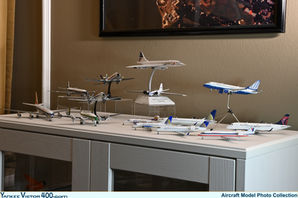
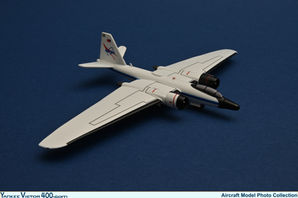


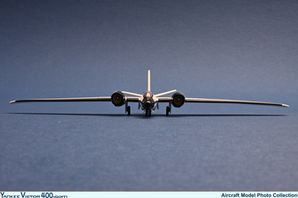


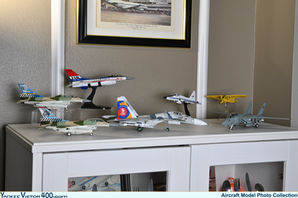

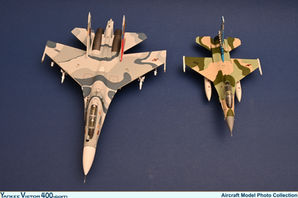
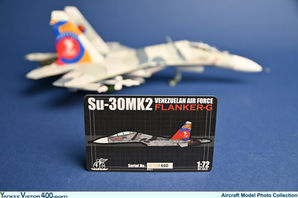
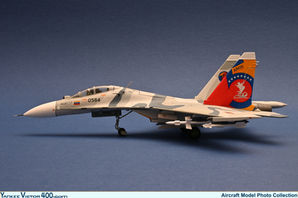










Nice review Jorge. The Cubana titles indeed look more bold on one side, very strange. Don't they apply the titles with the same machine at the same time?